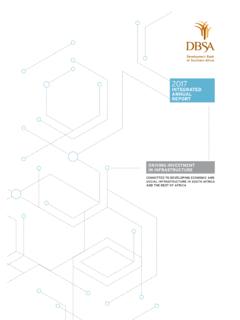Transcription of ANNUAL REPORT 2011 - UNICEF
1 ANNUAL REPORT 2011 UNICEF BOTSWANAA cknowledgementsThis REPORT was written by Constance Formson UNICEF Botswana Social Policy Specialist ( ), under the leadership of Marcus Betts, Deputy Representative based on contributions from colleagues in the Young Child Survival and Development Section and the Child and Adolescent Protection and Participation Sections. Special thanks are due to Sarah Banks of Kolobe Design for her work in laying out the from this publication may be freely reproduced with due acknowledgement. The United Nations Children s Fund ( UNICEF )Botswana Country Office 2012 Design: Sarah Banks, Kolobe Design Photographs1: UNICEF Botswana/ 2011 /Dave Clift.
2 UNICEF Botswana/ 2011 /Kebitsaone Kelaotswe and The majority of these photographs were taken at a Children s Art Fair held on 18 and 19 November 2011 as part of the commemoration of the Convention on the Rights of the REPORT 2011 Passionate People, Championing Children, Dedicated to DeliveryUNICEF BOTSWANA2unite for childrenACSD Accelerated Child Survival and DevelopmentAIDS Acquired Immune Deficiency SyndromeART Anti-Retroviral TreatmentARV Anti-RetroviralBAIS Botswana AIDS Impact SurveyBFA Botswana Football Association BFHS Botswana Family Health SurveyBLFS Botswana Labour Force SurveyCCF Children s Consultative ForumCHAI Clinton Health Access InitiativeCHDs Child Health DaysCRC Convention on the Rights of the ChildDIVA Diagnose Intervene Verify AdjustDSS Department of Social Services FIFA F d ration Internationale de
3 Football Association /International Federation of Association Football GoB Government of BotswanaGDP Gross Domestic ProductHIES Household Income and Expenditure SurveyHIV Human Immunodeficiency VirusIMR Infant Mortality RateM&E Monitoring and EvaluationMFDP Ministry of Finance and Development Planning MICS Multiple Indicator Cluster SurveyMoESD Ministry of Education and Skills Development MOH Ministry of Health MTCT Mother to Child TransmissionNACA National AIDS Coordinating AgencyNCC National Children s CouncilNDP National Development PlanNER Net Enrolment RatioNPA National Plan of ActionOVC Orphans and Vulnerable ChildrenPMTCT Prevention of Mother to Child TransmissionPSS Psychosocial support SADC Southern African Development Community U5MR Under-5 Mortality RateUN United NationsUNAIDS The Joint United Nations Programme on HIV/AIDSUNDAF United Nations Development Assistance FrameworkUNDP United Nations Development ProgrammeUNFPA United Nations Population FundUNICEF United Nations Children s FundAcronyms3 UNICEF BotswanaTable of ContentsAcknowledgements 2 Acronyms 2 Foreword 5 The Situation of Children and
4 Women in Botswana 6 Household Poverty and Inequality 6 Child Population 7 Political and Economic Developments 7 Situation of Orphans and other Vulnerable Children 8 Child Protection and Participation 9 Country MDG Progress 9 Key Challenges and Opportunities 17 UNICEF Programme Progress in 2011 20 Governance and Human Rights Promotion 21 Economic Diversification and Poverty Reduction 22 Health and HIV 23 Children, Youth and Women Empowerment 26 Partnerships 28 UNICEF Botswana Funding and Expenditure 2011 332012 Outlook 34 The UNICEF Botswana Team 354unite for childrenForeword5 UNICEF Botswana This ANNUAL REPORT provides a review of progress during 2011 against the planned results of the UNICEF country programme for the period 2010-2014.
5 The current country programme contributes towards the achievement of the 10th National Development Plan (NDP10) in areas directly and indirectly affecting the survival, development, protection and participation of children and key results for the UNICEF programme of cooperation are to contribute to: (a) reduction of under-five mortality; (b) reduction of incidence of HIV among young children; (c) reduction of adolescent girls risk and vulnerability to HIV; and (d) reduction and mitigation of violence, abuse, neglect, discrimination and exploitation of children.
6 Through this REPORT we hope to provide the reader with a summary of issues affecting children as well as progress made in Botswana towards achieving the child-related Millennium Development Goals. In addition, during the course of 2011 , two key developments have reaffirmed the direction that the UNICEF country office will take in the coming two years. Firstly, the secondary analyses of existing survey data provides the evidence base with which to better advocate for children s rights in Botswana. Secondly, the programme has taken a fresh look at our work through an equity lens to ensure that issues of disparity and vulnerability inform all our work in support of the children of Botswana.
7 Both these developments reveal that yes we are on the right track and have made inroads towards improving the well-being of children in Botswana. At the same time, there remains more to be done to address the unfinished development agenda for children, to reach those children in pockets of deprivation, and to afford them equal opportunity to achieve their full potential. As we forge ahead towards achievement of our joint endeavours, on behalf of UNICEF Botswana I would like to express my continued appreciation to the Government of Botswana and all our partners for your support and commitment towards the well-being of all Batswana children.
8 Pula!Dr. Doreen Mulenga MB ChB, MPH UNICEF Representative, BotswanaForewordThis ANNUAL REPORT provides a review of progress during 2011 against the planned results of the UNICEF country programme for the period 2010-2014. 6unite for childrenWThe Situation of Children and Women in BotswanaWithin four decades Botswana has developed from a least developed country at independence in 1966 to an upper middle income country. This progress has been primarily due to prudent use and management of mineral resources and a stable democratic governance system, with regular free and fair general elections.
9 Despite being an upper middle income country, Botswana continues to face development challenges such as high HIV prevalence rates, high mortality rates among both children and women; persistent poverty and inequality; high unemployment especially among youth; vulnerability to external shocks due to lack of diversification of the economy beyond Poverty and Inequality The proportion of people living below the national poverty line declined from 47% to 31% between 1993/94 and 2002/3 respectively, and declined further to 21% in 2009/10. 1 Analysis of the 2002/3 data showed income distribution to be among the highest in the world: the wealthiest 20% of households earned 67% of total income, while the poorest 40% of households earned only 11% of total income.
10 Past poverty analysis also revealed that poverty in Botswana has distinct rural and gender dimensions with higher prevalence in rural areas and among female headed households with children and widows. Despite extensive investment in social protection and safety net measures to mitigate poverty, poverty in Botswana remains persistently high for a country of upper middle income status. Recent analysis on poverty in Botswana based on the Within four decades Botswana has developed from a least developed country at independence in 1966 to an upper middle income country.















